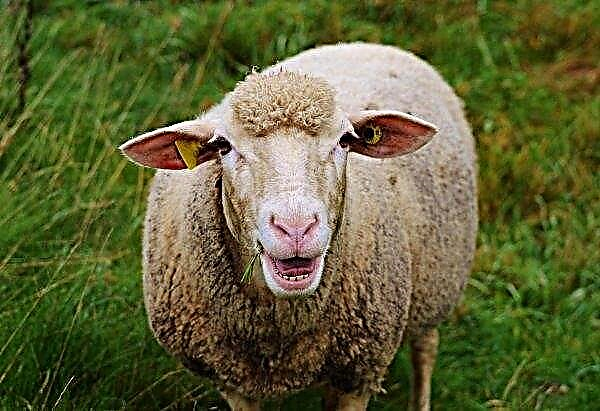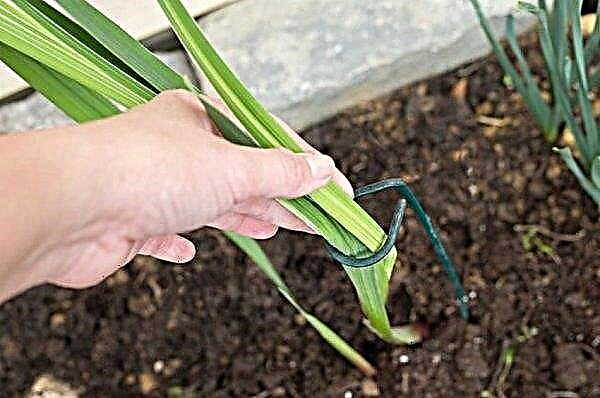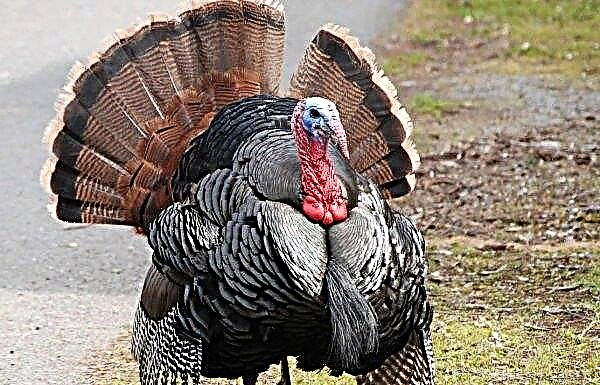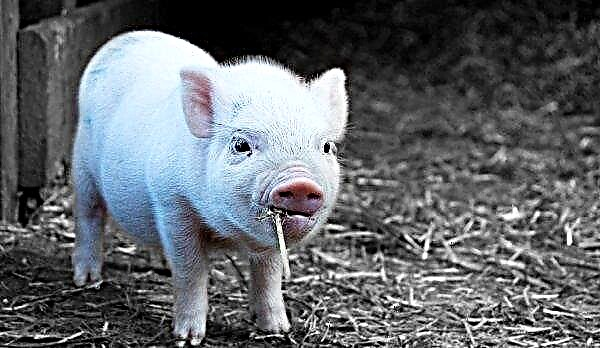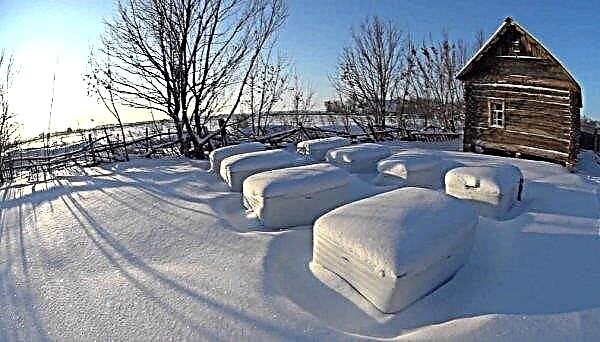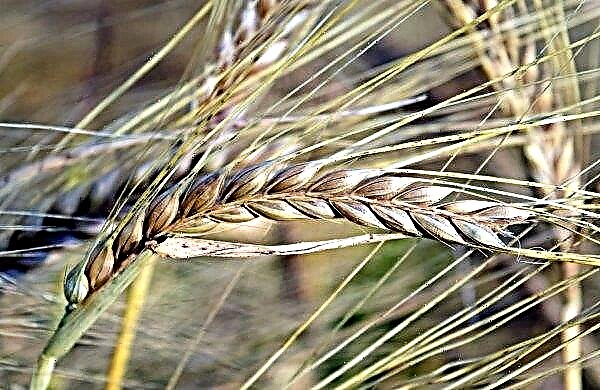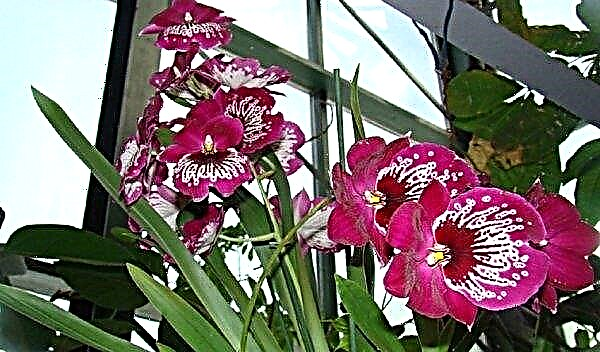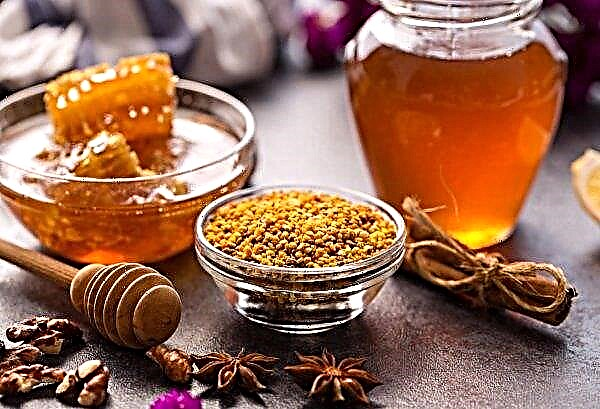Amazing flower - hydrangea is named after the princess of the Roman Empire. The plant has the scientific name hydrangea, comes from America and Asia. Dolly belongs to the panicled species of the mentioned culture and is a shrub on which inflorescences are formed in the form of panicles. Panicled Dolly is a novelty of modern selection and is included in the list of varieties of hydrangeas most demanded by gardeners.
Hydrangea Variety Description
Hydrangea Dolly is a shrub that has a spherical spherical shape. It reaches a height of 130–150 cm, and the length of conical inflorescences-panicles is about 30 cm. The flowers are small, white, and, as they age, turn into pastel pink, with a rich and pleasant aroma. With proper care, the plant is able to bloom in the first year after planting. The variety is winter hardy and can withstand a decrease in air temperature to -35 ° C.
Did you know? The color of hydrangea petals directly depends on the acidity of the soil. In acidic soils, flowers acquire a blue hue, and in more alkaline soils, they have pink or purple petals.
Application in the interior of the garden
Panicled Dolly will be a wonderful decoration of any garden or flowerbed, and due to its compact size it can accommodate in a small area. It is better to plant it near a lilac or mock-up, as their flowering ends in May, and hydrangea only begins to bloom during this period and will continue to delight others with its bright appearance. The spectacular bush goes well with conifers, such as juniper, thuja or fir. Regardless of the general concept of the garden, Dolly fits perfectly into the outline of the landscape and gives everyone a great aesthetic pleasure.
Landing
Hydrangea propagation is carried out at the expense of green cuttings from the shoots of the current year, although there are other methods of planting, for example - dividing the bush. However, for inexperienced gardeners, it is better to purchase a ready-made seedling with a closed root system. When planting, it is important that the soil is acidic, and in the case of an alkaline soil reaction, it can be acidified using citric acid. To do this, apply a solution consisting of 5 g of acid and 10 liters of water, the volume of which is designed for 1 m² plot.
Landing time
Shrubs can be planted in open ground in spring or autumn. At the same time, it is important that the average daily temperature is not lower than + 15 ° С and there is no threat of night frosts. During the autumn planting, it is necessary to choose the time so that before the onset of frost there will be at least two weeks left, during which the plant can have time to grow roots and take root. In spring, hydrangea is planted in late April or early May, and in autumn - in September - October.
Important! When planting hydrangea in alkaline soil, additional application of mineral fertilizers is required, which restore and increase the acidity of the soil. For example, double superphosphate, calculated at 70 g per 1 m² or urea — 15 g per 1 m².
Site selection and soil preparation
Hydrangea Dolly grows better on moist and acidic soil with a pH level of 4 to 6 units. Unlike other plants, culture prefers places without direct sunlight (in the form of openwork shade) or partial shade. The constant exposure to ultraviolet light slows down the growth of the flower, making it small and unattractive. For better hydrangea growth before planting, it is necessary to create the optimal soil mixture at the planting site, adding to 4 kg of chernozem how much humus, 2 kg of peat and sand.

Landing algorithm
During planting panicled hydrangea, the following sequence of actions must be performed:
- Choose a seedling with a closed root system, and place it for several hours with its roots in the water.
- Dig a hole measuring 30 × 30 × 30 cm. When planting several bushes, the distance between them should be at least 1 meter.
- Lay out the bottom of the recess with a drainage layer of small stones, gravel, etc., 5-6 cm thick.
- Pour 3-4 liters of water into the recess.
- Place the roots of the flower in a pit, and fill it with a previously prepared soil mixture, not higher than the level of the root neck of the plant.
- Well tamp the soil near the plant.
- Around the bush at a distance of 40 cm from the central shoot, fill the soil with organic mulch, for example, sawdust, the layer of which should be 3-4 cm.

Care
Hydrangea Dolly does not require special skills in the care and cultivation, but the plant needs regular watering, fertilizing and loosening the soil. It is also important to properly prepare the bush before the winter season. To eliminate damaged, sick and dry branches of the shrub, it is recommended to trim hydrangea in spring and autumn. At the same time, cutting branches contributes to the rapid growth of the bush due to young erect shoots.
Watering
Panicled hydrangea should be watered regularly, but in moderation, since the plant loves moisture, but the roots can rot under its excessive influence. Regular intake of moisture enhances the growth of the bush and prolongs the flowering period. Young seedlings should be watered with 5 liters of water 2-3 times a week. An adult plant will need a single watering of 20 liters of water.

Top dressing
In the spring, once, hydrangea Dolly should be fed with nitrogen fertilizers, as they enhance the growth of young shoots, contribute to the growth of the root system and the full formation of flowers. For this purpose, you can use urea or ammonium nitrate, from which an aqueous solution is prepared at the rate of 50 g of substance per 5 l of water. Fertilizer prepared in this way will be enough to water a 10 m² plot.
Thanks to potash fertilizers, the plant's sensitivity to moisture deficiency decreases, and resistance to diseases, pests and frosts increases. The most common varieties of this type of fertilizer are potassium sulfate and potassium sulfate, which should be applied twice - in spring and autumn. They are produced in the form of granules and poorly soluble in water, so they are embedded in the soil at the rate of 20-30 g per 1 m².

Phosphorus fertilizers such as diammophos or superphosphate increase the resistance of hydrangea to temperature extremes and contribute to the fastest growth of bark in young shoots of shrubs. Fertilizer should be applied in the fall - 20 g per 1 m². To do this, you need to dissolve 100 g of the granules of the substance in 10 l of water and pour under a bush.
Loosening and weeding
Loosening the soil around the shrub helps the roots of the plant breathe and absorb moisture better, so this procedure should be carried out at least once a month. Together with loosening, it is important to remove weeds located near hydrangeas, as they “take away” nutrients and prevent the root from growing normally.
Weeding is also recommended once a month. After loosening, you can mulch the soil around the bush, filling it with sawdust, small particles of bark or tyrsa, a layer of 5-6 cm.
How to prepare for winter
To make the plant better tolerate a decrease in air temperature, even at the end of summer it is necessary to introduce phosphate fertilizers, which will contribute to the rapid maturation and covering of young shoots with bark. For this purpose, you can use double superphosphate at the rate of 20-25 g per 1 m² of soil. An adult hydrangea bush in the southern regions does not require shelter before wintering, but if the temperature in the Dolly growing region drops below -30 ° C, then the bush should be covered.
 Young and weakened plants need shelter. To this end, it is best to use spruce spruce branches, which are placed with thicker branches up and secured around the shrub with a twine. The shelter should not damage or break the branches of the plant, so strongly sprawling bushes are pre-tied with rope.
Young and weakened plants need shelter. To this end, it is best to use spruce spruce branches, which are placed with thicker branches up and secured around the shrub with a twine. The shelter should not damage or break the branches of the plant, so strongly sprawling bushes are pre-tied with rope.
Breeding
To expand garden planting with new bushes of hydrangea Dolly is possible in several ways. However, this process of reproduction of the described deciduous shrub is rather laborious and requires special knowledge and skill from the gardener. The simplest method is to divide the bush, but with it you can get only a few plants.
Important! When propagating hydrangea Dolly using seeds, not all varietal traits of the plant can be preserved, so this method is not used.
The maximum number of full-fledged seedlings is in the case of cuttings, but such planting material requires constant care, otherwise it may not take root in the future.
Cuttings
Cuttings are the simplest and most effective method of propagation of hydrangea. The best annual roots are green shoots that need to be separated from the bush in mid-summer, when buds have already appeared. For cuttings, large young branches with a significant number of buds are taken, separated from the plant and a pot or glass with soil is placed. At the same time, it is important to make holes for the germination of roots at the bottom of the containers, and remove the lower leaves from the stalk.

In order to grow a viable seedling from hydrangea cuttings, you need to find a darkened place in the garden and create a small greenhouse there, using a film sleeve fixed with two pieces of bent wire. Previously, in the place of installation of the greenhouse, they dig a hole (trench) 30 cm deep, where containers with cuttings will be placed, and 4-5 kg of sand are poured on the bottom.
Did you know? After cutting, the hydrangea flowers wither almost immediately, but for a longer preservation of the presentable appearance of the bouquet, the surface of the slices must be placed in boiling water for several seconds.
After that, the pots are placed in a greenhouse and watered. Later, the humidity inside the greenhouse is maintained with a spray gun, which plants are sprayed with 2 times a day. In autumn, hydrangea Dolly is planted in open ground.
Layering
To obtain a seedling by the above method, it is necessary to bend and sprinkle with earth last year's branches. The procedure is best carried out in the spring, then in the fall layering will take independent roots into the soil and it can be separated from the mother plant. Separation is also carried out in the spring, so that the plant has a better chance of wintering. To do this, hydrangea is dug up and transplanted to a suitable site.
Dividing the bush
This method of propagation of hydrangea Dolly is the simplest and guarantees a high survival rate of bushes. However, the procedure can only be done once every two years to enable the plant to gain strength. Another disadvantage is that from one bush you can get no more than two seedlings. Separation of the bush is carried out using a garden shovel, digging out part of the rhizome with shoots. Division of the bush is best done in the spring.

Diseases, pests and their treatment
Hydrangea rarely gets sick and this is due to such reasons:
- wrong seedlings;
- violation of planting conditions;
- lack of nutrients.

Most often, hydrangea Dolly is affected by fungal diseases, such as white or gray rot, which begin with rotting of the roots. Powdery mildew manifests itself in the form of yellow-brown spots on leaves that later fall off. Such infections are effectively treated with fungicides: Fitosporin, Chistotsvetom or Fundazolom (according to the recommendations specified in the instructions). It is also necessary to remove all dry and damaged parts of the plant.
Downy mildew appears in the form of oily spots on the leaves and stems, which darken over time, and the appearance of brown spots with a bright middle and dark rim is a sign of septoria. To get rid of these pathologies, it is necessary to treat hydrangea with a solution of 10 l of water, 15 g of copper sulfate and 150 g of soap.
Ring spotting refers to viral diseases and manifests itself in the form of circular blurry spots on shriveled leaves. Hydrangea at the same time ceases to bloom and does not grow. The disease cannot be treated, and the affected bush must be disposed of (burned).Did you know? Among the plants belonging to the Hortense family, you can find about 80 different species of this flowering shrub.

The most dangerous pest for panicled dolly is leaf aphid, which sucks the juice from the plant and leads to its death. For its destruction, it is necessary to spray the shrub with the Iskra or Oktara preparations in accordance with the instructions.
Hydrangea also often suffers from pests such as snails, which can be collected by hand. If small yellow spots appeared on the back of the leaf, then this is a spider mite. To eliminate it, you need to treat the shrub with the preparations "Lightning", "Vermitek" or "Thiophos" (following the annotations to the preparations).

Each gardener will be happy to plant a bush of panicled Dolly, because the plant is distinguished by tenderness and grace. Even if you place a single bush in the garden, the site will immediately transform and will look more elegant. At the same time, a hydrangea flower is easy to grow and care, so that everyone, even a beginner summer resident, can grow a plant in his garden. Another undoubted advantage of the bush is that Dolly is able to delight the eyes with delicate colors for a long time, because the variety has a long flowering period.

